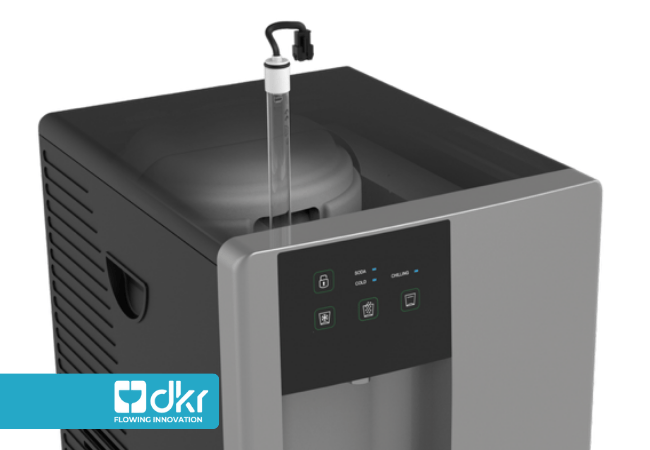


Building on our decades of experience in the water distribution industry, we at DKR have witnessed and contributed to the evolution of technical language. In this article, we want to explore the term 'naturised water'a trendy concept today that is closely linked to a specific brand. We tell the story of how a registered trademark and its innovative UV disinfection technology have managed to become synonymous with a product category, profoundly influencing our industry and the way we communicate water solutions, even though there are now several technical alternatives for achieving similar results.
Over these four decades, we have observed how market needs have evolved, prompting us to diversify our offer. Today, in addition to our traditional water distribution services, we have extended our competencies the supply of dry ice in Lombardy and neighbouring provinces, thus responding to the growing demands of the industrial and food markets.
In the commercial landscape, we often witness a particular linguistic phenomenonSome terms of common speech derive directly from the products that launched them. Who among us has never said 'pass me a Kleenex' instead of handkerchief, or not asked for 'a Post-it' to refer to any sticky note? Similarly, when we talk about adhesive tape we say 'the Scotch', and for ballpoint pens we use the term 'Biro'.
This process of generalisation represents the greatest commercial success a brand can achieve: becoming synonym of the product category it represents. However, it also brings challenges from the point of view of intellectual property and brand positioning.
In the area of water filtration, we have witnessed a similar phenomenon with the term 'naturalised' or 'naturised'. This term, originating from a specific brand, has become in common usage synonymous with a particular category of naturalised water.
Naturizzata is a registered trademark of Sidea, a Tuscan company that has been operating in the domestic, Horeca and water filtration sector since the 1990s. The company has patented this term to identify a particular water treatment process. The concept of naturalised water, as we will see later in the article, represents one of the treatment methods available on the market, which can be realised through different technologies and production approaches. Trademark registration has set a terminological precedent in the industry, although processes to achieve similar results can now be implemented with various alternative technical solutions.
The technology developed by the Tuscan company, protected by a dedicated patent, is based on a system called 'Naturizer'. This innovation consists in the inclusion, in the filtration package as the last stage, of a UV lamp constructed differently from those normally used in the industry for the production of filtered water.
The heart of the innovation lies in the management of the passage time of water in contact with the UV rays produced by the lamp. The system channels the flow through a quartz made coil that circulates around the lamp, creating a optimised route for water exposure to ultraviolet rays and thus ensuring that the contact time is as desired by the manufacturer.
This system ensures that the contact time between water and UV rays is sufficient to guarantee proper antibacterial action. The serpentine configuration of the quartz significantly increases the water path, allowing prolonged and uniform exposure to sterilising UV rays.
The effectiveness of the system naturally depends on the state of quartz maintenancewhich must remain perfectly transparent in order to ensure the optimal passage of UV rays. However, this maintenance requirement is common to all UV lamps on the market and is a standard aspect of the operation of these natural water production systems.
The product has achieved considerable success in the market, so much so that we have often encountered calls for tenders from public bodies in which naturised water' was expressly requested to indicate drinking water treated with a filtration system. This use of the term in official documents shows how the brand has managed to become a standard reference in the industry.
The specific demand for naturised water in public tenders has contributed significantly to the spread of this terminology in the professional sector.
In addition to the patented 'Naturizer' system solution, there are other methods of ensuring adequate contact time between water and UV radiation within UV filters. The choice of the most appropriate system depends on the specific requirements of the installation and the characteristics of the water flow.
One alternative is to adjust the output flow according to the size of the UV filter installed. This approach allows the water residence time in the UV chamber to be optimised without requiring significant structural changes to the system.
Another effective strategy involves oversizing the UV filter in relation to the capacity delivered by the dispensing machine downstream of the filter. This approach ensures that even at times of peak demand, the water receives adequate UV treatment.
Over-dimensioning also offers additional safety margins and can compensate for any reduction in efficiency due to ageing of the lamp or other operational factors.
As DKR, we continue to monitor and evaluate technological innovations in the water filtration industry. The history of naturitised water teaches us how technological innovation, when combined with an effective business strategy, can not only win market share, but also influence the very language of the industry.
Our 40 years of experience has taught us that success in the water distribution sector requires a balance between technological innovation, service reliability and understanding of customer needs. While we continue to expand our services into new areas, we always keep the quality and safety of the water we distribute at the centre of our mission.
The evolution of the industry continues, and we at DKR are ready to meet future challenges, strengthened by our experience and our ability to adapt to new technologies and changing market needs. For any information about our activity, please contact us at contact us.